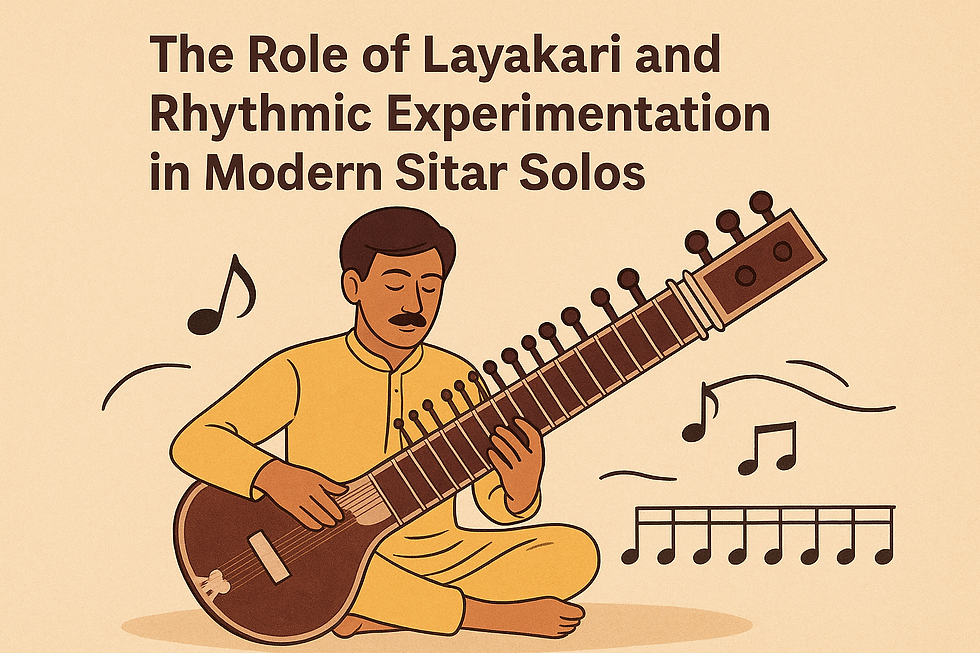"From Calm to Climax: The Role of Jhala in Sitar Performance"
- Sharanya naidu
- May 27
- 3 min read
Updated: Jul 16
If you're learning Indian classical music, especially the sitar, you've probably felt that exhilarating moment in a performance when the energy suddenly surges, building to an incredible peak. That's the magic of Jhala, and it's a key to creating unforgettable musical experiences.
Understanding Jhala isn't just about mastering a specific technique; it's about unlocking the secret to dramatic impact in a sitar performance.

What is Jhala, Anyway?
Think of a musical journey with a thrilling grand finale. The Jhala is precisely that grand finale in a sitar performance—the powerful culmination of all the musical ideas presented earlier in the raga.
Essentially, Jhala is a section within a raga performance (usually near the end) that's all about fast, rhythmic strumming and percussive elements. The sitarist focuses heavily on the chikari strings (the drone strings on your sitar), using a driving, often relentless, right-hand technique. This creates a powerful, rhythmic conversation, often in close partnership with the tabla player.
You'll generally hear two main types of Jhala:
Tihai-based Jhala: Here, the focus is on repeating a short, rhythmic phrase (a tihai) three times, which resolves strongly on the beat. This builds incredible anticipation and gives a definitive ending to a section.
Gat-based Jhala: This type expands on the melodic themes of the raga's main composition (gat), but it's played at a very high speed with intense rhythmic articulation.
How Jhala Creates that Climactic Feeling
The beauty of Jhala lies in its ability to dramatically escalate the energy and excitement of a performance. Here's how it works:
Pounding Tempo and Intensity: After the often meditative and expansive sections of the alap and jor, Jhala explodes with a surge in tempo. This sudden acceleration immediately grabs your attention, creating a palpable sense of urgency and excitement.
Driving Rhythm and Tihai: The repetitive, percussive strokes on the chikari strings create a hypnotic rhythmic pattern. The frequent use of tihai—that phrase repeated three times to land perfectly on the beat—builds incredible tension before releasing it with satisfying resolution. It's like a series of mini-climaxes leading up to the main event.
A Showcase of Skill: Jhala is where the sitarist truly lets loose their technical prowess. The lightning-fast strokes, intricate rhythmic variations, and precise coordination with the tabla player are mesmerizing to witness. This display of skill pulls you deeper into the performance.
The "Driver" Effect: The strong, rhythmic nature of Jhala acts as a powerful "driver," propelling the performance forward. It transforms the sitar from a purely melodic instrument into a rhythmic powerhouse, creating a thrilling percussive texture alongside the tabla.
The Big Release: The ultimate climax of a sitar performance often arrives with the final, emphatic tihai of the Jhala. This abrupt, definitive ending provides a profound sense of closure and release, leaving you breathless and deeply satisfied.
Tips for Music Learners
For those of you learning the sitar or any instrument in this tradition, here's how to truly appreciate and eventually master the art of Jhala:
Listen Actively: Don't just focus on the melodies. Pay close attention to the rhythmic aspects of sitar performances. Try to pinpoint the Jhala sections and notice the different patterns and the incredible interplay between the sitar and tabla. Feel how the energy shifts.
Master Your Right Hand: Jhala depends heavily on a strong and consistent right-hand strumming technique. Practice your da (downstroke) and ra (upstroke) with precision and power. Rhythmic exercises will be your best friend here.
Understand the Raga's Structure: Jhala isn't an isolated event; it's a vital part of the raga's overall journey. Understanding how the alap, jor, and gat build and lead into the Jhala will give you a much deeper appreciation for its role in creating that grand climax.
Practice with a Metronome or Tabla: To truly nail the rhythmic precision needed for Jhala, practice with a metronome. Even better, practice with a tabla accompaniment if you can! This will help you develop a rock-solid sense of time and rhythm.
Jhala is far more than just a fast passage; it's a meticulously crafted section designed to evoke excitement, showcase skill, and bring a raga to its powerful conclusion. By understanding its techniques and its crucial role, you'll not only appreciate sitar performances on a much deeper level but also gain invaluable insights into how to build your own compelling musical climaxes.
So, keep listening, keep practicing, and let the magic of Jhala inspire your musical journey!



Comments